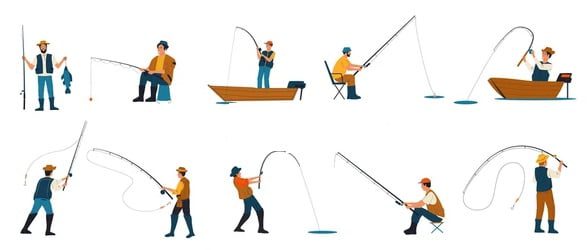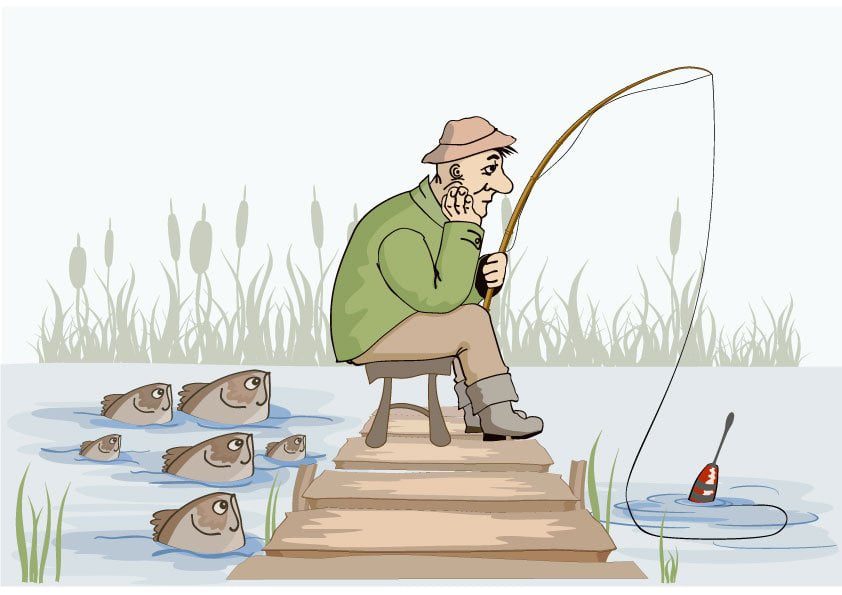Fishing - a very old activity that has been an important part of human life for more than 40,000 years. In many parts of the world, fish was the main source of food, so the local population had to know how to catch it. Over the centuries, different peoples have invented different ways of fishing to survive in the environments they found themselves in. So, in this article we will look at some of the oldest traditional fishing methods and how they have changed over time.
Underwater fishing
Underwater fishing - a very old method of fishing, used by fishermen all over the world for thousands of years. According to the earliest records of spearfishing, harpoons were used in India and France as far back as 16,000 years ago. Since then, countless stories and religious texts have described the use of scepters and tridents. The most recognizable is the Greco-Roman sea god.
Native American tribes, such as the Hupa, have been using nets to catch fish for over a millennium. Beggar, though throwing was not the only way to catch fish. With the advent of archery, many tribes took to the waters and thus archery became established.
Tribes such as the Negritos, who lived in what is now the Philippines, traditionally fished with bows in the shallows where the water was clear. Even though the tribesmen mainly fished in shallow waters, they still had to use a lot of skill to get the cast right because the light was refracted when it reached the water. They caught yellowfin carp, grouper, kingfish and many other species of fish.
Spearfishing hasn't changed much over the years. Today, in many US states around the Gulf of Mexico, fishing methods such as netting are popular for catching flounder. For example, in the Bahamas, diver-fishermen use spears made of a metal rod with a spearhead and a rubber loop, or lines (shooters) to fish for larger species of fish around the reefs.
Angling
Angling is perhaps the most common and also one of the oldest fishing methods. When fishing, a hook (angle) is used, which is attached to the fishing line. Historically, the hook was usually baited, which varied from area to area depending on what people had.
Fishing hooks have been used since the Neolithic. The oldest hooks ever found were found in Sakitari Cave, Okinawa Island, Japan and are over 22,000 years old. The first hooks were quite primitive compared to the hooks used today, made from bone fragments, shells, animal horns and bird beaks.
However, it didn't take long for angling to evolve. Our ancestors quickly discovered that they could sink hooks by attaching weights (weights) to them. Around 800 BC, the ancient Greeks took fishing to unprecedented heights by studying the migratory patterns of tuna and other species of fish.
When it comes to angling, two main fishing methods are distinguished:
- line fishing: a hand-held line that is lowered into the water (usually from a higher place, such as a bridge or cliff).
- Fishing with a pole: a simple pole with a line and a hook attached to it. More than 4,000 years ago, the first anglers made rods from bamboo.
It can be said that it is thanks to angling that today fishing has become a very popular pastime from hunting for the sake of survival. In such 17th century books as The Compleat Angler and The Secrets of Angling glorifying the art and spirit of fishing of the time, while meticulously revealing the intricacies of the sport. These types of books have fueled the popularity of techniques such as fly fishing.
Ice fishing
Ice fishing - this is catching fish under the ice in a frozen body of water. Ice fishing, traditionally practiced in the colder northern regions of the world, has retained its original form for more than a millennium. Like regular fishing, ice fishing includes both spearfishing and angling. However, there are some nuances.
For peoples like the Inuit, ice fishing has always been an important part of life. So it is not surprising that thanks to them, one of the most ingenious fishing methods and tools ever used was invented. In order to catch fish under the ice, the Inuit developed a unique toothed net called kakivak. This stingray was made from a strong center spike and two more flexible side branches. Each side branch had an inward-facing blade that hooked the fish and thus prevented it from escaping.
The culture of ice fishing is extremely well preserved in countries such as Canada, Norway, Finland, Latvia, Estonia, Russia and the United States of America. Many of these countries host annual ice fishing tournaments that attract thousands of enthusiastic anglers.
Trapping
Of course, the Inuit excelled at fishing even when the waters were not frozen. One method of fishing they used required stone dams.
The Inuit built dams by stacking stones in a crescent shape in the river bed. The stones were piled up to a certain height, leaving only one narrow opening for the fish to swim away. When a fish entered this corridor, the fishermen would throw theirs into it kakivak.
Stone dams were also widely used in medieval Europe. In England, for example, stone dams were so widespread that some rivers eventually became impassable. The very famous Charter of Great Liberties prohibited the building of these stone dams in all fresh waters of England.
However, not all dams were made of stone. Many African tribes built wooden dams, so the water level dropped to the point where fish could barely swim. Fishermen had to collect them with their bare hands. We will now move on to another group of traditional fishing methods.
Catching by hand
Sometimes you don't even need fishing equipment to catch a fish. There are a number of ancient methods of catching fish and seafood by hand. Contemporary conservation issues have made some more controversial than others. The methods of hand fishing for catching fish are as follows:
- Diving in search of clams, crabs or lobsters.
- Catching catfish with bare hands. Fishermen would stick their hands into the catfish's hole and wait for it to hook. This method is still popular in the American South. However, bare-handed fishing is dangerous for both fishermen and fish, and most US states have banned the practice.
- Trout tickling. This method has been practiced for many centuries and is mentioned in many historical and literary texts, from ancient Greek poems to the works of Shakespeare. The fisherman tickled the trout's belly until it went into a paralyzing trance. Nowadays, tickling trout is mostly prohibited.
- Trampling. A centuries-old method traditionally used in south-west Scotland to catch plaice. Fishermen would search for flounder by trampling their bare feet in the sand. When they found a fish, they would press it with their feet and pierce it with a berker (a local form of trident). Until 2010, thousands of enthusiasts gathered at the local Urr river for the world championships of flounder catching by trampling. However, in 2011, local regulatory authorities decided to discontinue the event due to environmental concerns.
Trapping with nets
People have been using it since ancient times networks to catch fish. The meshes of these fishing nets were wide, made of fine threads, allowing fishermen to catch more fish than ever before. The ancient Greeks recorded how nets would "catch fish while men slept."
Of course, there are many types of fishing nets. The most commonly used are:
- Nets are cast. These nets have a mesh with an opening on the upper side. Fishermen would cast these nets over a shoal of fish swimming in shallow waters.
- Gill nets. Fishermen used to dip these nets in the water in places where fish often passed by. They attached corks to the edges of the nets to make the nets buoyant, and weights in the middle so that the nets covered a considerable area of water. Fish would become entangled in the nets because of their gills, and all the fishermen had to do was collect them.
Recently, netting has become a growing concern. With recreational and commercial net fishing largely unregulated worldwide, the outlook for marine life is not good.
Fishing with kites
Oddly enough, kite fishing has a long and successful tradition. This method came about thanks to the Polynesian islands, where local fishermen had to find a way to overcome the area's inhospitable reefs. The first written evidence of kite fishing dates back to the 1500s, when Dutch expeditions traveled through the area.
Using only local materials, these fishermen have made very effective fishing kites. These kites floated baits just below the surface of the water, thus attracting many fish such as anglerfish.
Kites were very simple devices: their "sails" were made of banana leaves and the line was made of tied spider webs. Eventually, the natives developed kites of stronger structure, the sails of which were made of stiffened fern (ie oak-leaf fern) fronds, and the line of baited loops.
Of course, with more modern materials, today's kite anglers can often catch big league fish like tuna or sailfish.
If you look at some of the traditional fishing methods mentioned today, you can see that they are very different. However, they have something in common - they are so simple and effective. Not all of these methods of fishing are appropriate or socially acceptable these days, but there is something to be learned from each of them and applied to yourself: you don't need a lot of technology to catch fish. Our ancestors really didn't need it.





